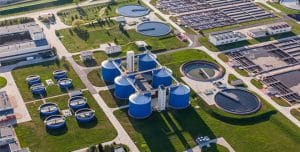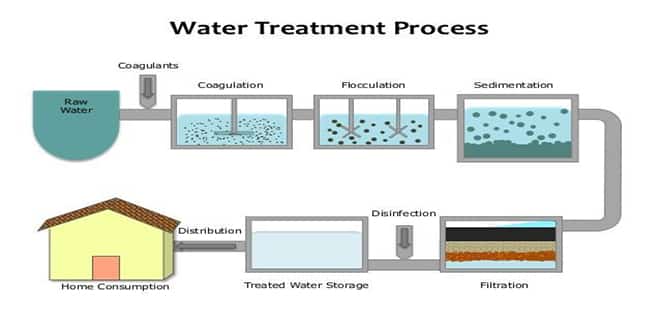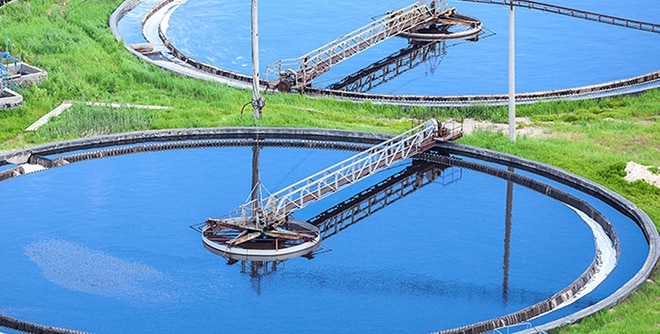Polyacrylamide is one of the most important and common water-soluble polymers, and due to its various properties, a significant part of water-soluble synthetic polymers are prepared on the basis of this polymer. Polyacrylamides have valuable properties such as flocculation, ability to achieve high molecular weights, reasonable price, and solubility in water under various conditions, and are widely used in water treatment processes (as coagulants and flocculants).
These compounds dissolve in water and by forming bonds with suspended particles in the water, colloids and contaminants cause these materials to clot, which can be easily separated after sedimentation, so the use of Polyacrylamide clarifies the water and removes contaminants suspended in water.
Why is the Coagulation Process Important in Water Treatment?
One of the common problems in the water and wastewater treatment industry is the presence of suspended particles that have a negative charge and a large number of them lead to the turbidity of water and reduce its quality. For this reason, positively charged chemicals are used to neutralize negatively charged particles and bind them together. This process is called coagulation in water treatment and is widely used in drinking water treatment plants.
What are the Types of Water Coagulants?
The materials used to coagulate suspended particles in water are very diverse and can be grouped based on various factors. One of the most important points in the use of coagulants in water treatment is the type of coagulant. In a general classification, water coagulants include metal and polymer coagulants, of which polymer is the most widely used. Among the polymeric coagulants in water treatment, we can mention polyacrylamide, which is soluble in water and in addition to water treatment, also is effective in improving soil properties.
Polyacrylamide in Water Treatment:
Polyacrylamide has various uses. Approximately 50% of the consumption of polyacrylamides is in the coagulation sector and in the water treatment industry. Suspended particles in water settle very slowly and sometimes never settle because they are small or electrically charged. Here, the task of polyacrylamide is to neutralize the electric charge of these particles, bond the particles to each other, and absorb them.
Types of Polyacrylamide for Water Treatment:
One of the most important factors in the application of this polymer in water treatment and removal and collection of suspended and colloidal particles is the compatibility of their type with pollutants. Contaminants in water are of different types anionic, cationic, and neutral, and based on this, cationic, anionic, and neutral polyacrylamides can be used. Anionic polyacrylamide is mostly used as a flocculant in water treatment.
Reasons for using Polyacrylamide in Water Treatment:
Polyacrylamide is one of the most widely used water treatment chemicals that are produced in different types of cationic, anionic, and neutral. These are polymer particles and are used for several important reasons in the process of water purification and removal of colloidal particles, some of which are:
- The strength and dissolution rate of these solid and liquid polymeric materials in water, ether, and ethanol is very high.
- In the process of purification and removal of suspended and colloidal particles in water with polyelectrolyte, less sludge is produced due to the use of mineral coagulants.
- Due to the very high strength of polyacrylamide particles in removing suspended and colloidal particles, the required amount of these materials is greatly reduced compared to other coagulants.
- The flocs produced by these polymeric materials have a larger volume and size than other flocculants
- The settling rate of coagulated particles by polyacrylamide is higher than in other materials
- No formation of harmful and dangerous compounds such as chlorinated hydrocarbons in the process of purification and removal of suspended particles
Of course, it should be noted that the cationic type of these polymers is more toxic than the anionic and neutral type, and for this reason, their use is prohibited in some countries, such as Japan.
Conclusion:
As mentioned, the purpose of using a coagulant such as a polyacrylamide in water treatment is to remove any solids and suspended particles. The use of this polymer in water purification makes these particles easily separated from water and settle, and will help to improve the color and remove water turbidity.









4 Responses
Which type of polyacrylamide is better to use for water treatment? Cationic or anionic?
In choosing polyacrylamide for water treatment and removal of suspended particles, it is necessary to pay attention to the type of particles and contaminants. Contaminants in water are in different types anionic, cationic, and neutral.
Accordingly, cationic, anionic, and neutral polyacrylamides can be used. Anionic polyacrylamide is mostly used as a flocculant in water treatment.
What combination should we use to remove polyacrylamide from water?
Hydrogen peroxide (H2O2) is a clear, colorless liquid that is slightly denser than water and is used to remove polyacrylamide from aqueous masses or other aqueous liquids containing acrylamide.